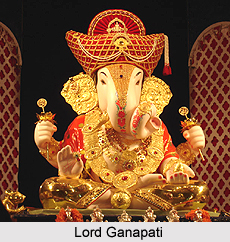 The Sri Ganapati Atharvashirsa or Ganapati Atharvashirsha Prayer is a Vedic religious scripture which is devoted to Lord Ganesha, also known as Ganapati, Vighneshvara, Ekadanta, Vinayaka, Vighnesa, Gajanana, Lambodara and Surpakarna. He is the son of Lord Shiva and Goddess Parvati and the elder brother of Lord Skanda (Kartikeya). Ganesha is widely worshipped through out the world and is also believed to be the Lord of learning and letters and the destroyer of pride, vanity and selfishness. He is venerated before the beginning of any new ritual or project. The work of Ganapati Atharvashirsa is considered as a late Upanishad which worships the deity as the incarnation of the ultimate Brahman. In the final line of the Sri Ganapati Atharvashirsa declares its own class as an Upanishad. The religious text is also known as the Ganapati Upanishad, the Ganapati Atharvasirsa, the Ganapati Atharvashirsha and Sri Ganapati Atharva Sirsha. In the Indian state of Maharashtra, the Sri Ganapati Atharvashirsa is extensively recited amongst the worshippers of Lord Ganesha, the Remover of Obstacles. The entire manuscript is composed over the doorway of the Astavinayaka Ganesha temple hall at Ranjangaon. It is widely believed that the Ganapati Atharvashirsa was composed by Sage Atharvan.
The Sri Ganapati Atharvashirsa or Ganapati Atharvashirsha Prayer is a Vedic religious scripture which is devoted to Lord Ganesha, also known as Ganapati, Vighneshvara, Ekadanta, Vinayaka, Vighnesa, Gajanana, Lambodara and Surpakarna. He is the son of Lord Shiva and Goddess Parvati and the elder brother of Lord Skanda (Kartikeya). Ganesha is widely worshipped through out the world and is also believed to be the Lord of learning and letters and the destroyer of pride, vanity and selfishness. He is venerated before the beginning of any new ritual or project. The work of Ganapati Atharvashirsa is considered as a late Upanishad which worships the deity as the incarnation of the ultimate Brahman. In the final line of the Sri Ganapati Atharvashirsa declares its own class as an Upanishad. The religious text is also known as the Ganapati Upanishad, the Ganapati Atharvasirsa, the Ganapati Atharvashirsha and Sri Ganapati Atharva Sirsha. In the Indian state of Maharashtra, the Sri Ganapati Atharvashirsa is extensively recited amongst the worshippers of Lord Ganesha, the Remover of Obstacles. The entire manuscript is composed over the doorway of the Astavinayaka Ganesha temple hall at Ranjangaon. It is widely believed that the Ganapati Atharvashirsa was composed by Sage Atharvan.
Lord Ganesha is worshipped as the Supreme Deity by the Ganapatya Sect. He comprises all other heavenly forms within himself. This belief is also presented in the opening passages of the Sri Ganapati Atharvashirsa. It mentions that the deity is the creator of the universe. He also sustains the universe and destroys it. Ganesha is depicted as the all pervading reality and an embodiment of the Atman or the eternal self. Moreover, the work mentions that the lord is identified with Aum (Om) and all the other Gods and deities in Hindu religion, such as Lord Shiva, Lord Vishnu, Lord Brahma, Lord Chandra, Lord Indra, Lord Agni, Lord Surya, Lord Vayu and others. He is also identifiable with the sun, the moon, air, fire, heaven, space and earth. He is also regarded as the Brahman and it is also believed that the 3 Lokas or worlds, namely Swargaloka, Antarikshaloka and Bhuloka are within Lord Ganesha.
Some passages of the Sri Ganapati Atharvashirsa depict that the Vedic religious text was influenced by Hindu Tantra and Tantric philosophies. Lord Ganapati is associated with the Mooladhara Chakra in a passage of the scripture.
Some of the lines from the work includes, "Om Namaste Ganpataye; Tvameva Pratyaksham Tatvamasi; Tvamev Kevalam Kartasi; Tvamev Kevalam Dhartasi; Tvamev Kevlam Hartasi; Tvamev Sarvam Khalvidam Bramhasi; Tvam Sakshad Atmasi Nityam; Hrtum Vachmi Satyam Vachmi; Ava tvam Mam; Ava Vaktaram Ava Shrotaram; Ava Dataram Ava Dhataram; Avanuchanavamv Shishyam Ava Paschatat; Ava Purastat Avo Uttaratat; Ava Dakshinatat Ava chordhvatat; Ava Dharatat Sarvatomam Pahi Pahi Samantat."




















